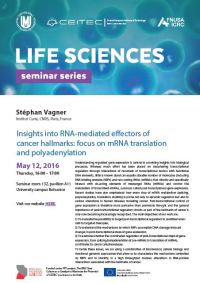Lunch in Campea at 12:00 (Thursday)
Abstract
Understanding regulated gene expression is central to providing insights into biological processes. Whereas much effort has been placed on deciphering transcriptional regulation through interactions of hundreds of transcriptional factors with functional DNA elements, little is known about an equally sizeable number of molecules (including RNA binding proteins (RBPs) and non-coding RNAs (ncRNAs) that directly and specifically interact with cis-acting elements of messenger RNAs (mRNAs) and control the metabolism of transcribed mRNAs, a process called post-transcriptional gene expression. Recent studies have also emphasized how every step of mRNA metabolism (splicing, polyadenylation, translation, stability) is prone not only to dynamic regulation but also to various alterations in human diseases including cancer. Post-transcriptional control of gene expression is therefore more pervasive than previously thought and the general importance of post-transcriptional regulatory circuits as part of the hallmarks of cancer is only now becoming increasingly recognized. The main objectives of our work are:
1) To evaluate the possibility to target post-transcriptional regulators to sensitize tumor cells to targeted therapies;
2) To understand the mechanisms by which RBPs accomplish DNA damage-induced changes in post-transcriptional steps of gene expression;
3) To examine whether the coordinated regulation of post-transcriptional steps of gene expression, from splicing/polyadenylation of pre-mRNAs to translation of mRNAs, contributes to cancer cell phenotypes.
To tackle these issues, we are using a combination of biochemical, cellular biology and functional genomic approaches that allow us to characterize the mechanisms controlled by RBPs and to identify, in a high throughput manner, alterations in RNA-protein interactions associated with the hallmarks of cancer.








